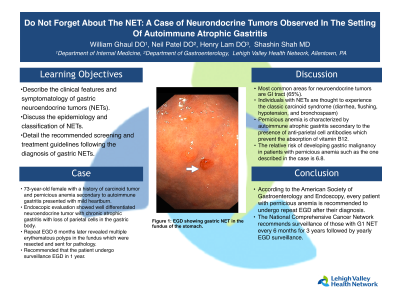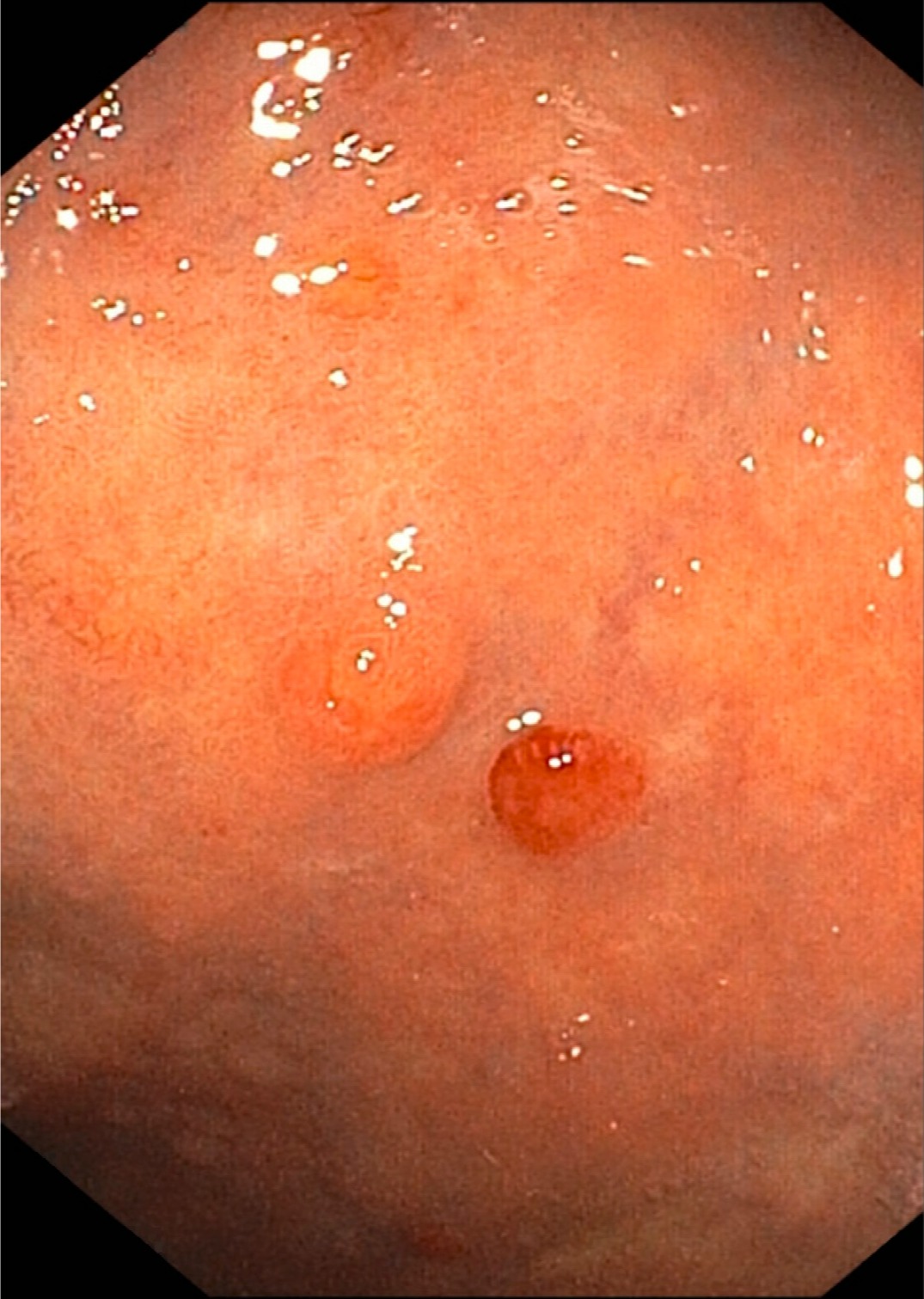Back


Poster Session A - Sunday Afternoon
Category: GI Bleeding
A0303 - Do Not Forget About the NET: A Case of Gastric Neuroendocrine Tumors Observed in the Setting of Autoimmune Atrophic Gastritis
Sunday, October 23, 2022
5:00 PM – 7:00 PM ET
Location: Crown Ballroom

Has Audio
- WG
William Ghaul, DO
Lehigh Valley Health Network
Allentown, PA
Presenting Author(s)
William Ghaul, DO, Neil Patel, DO, Henry Lam, DO, Shashin Shah, MD
Lehigh Valley Health Network, Allentown, PA
Introduction: Neuroendocrine tumors (NET) can arise from various locations in the body. The GI tract and the lungs make up the majority of sites. NET cells produce secretory granules with markers such as chromogranin A and synaptophysin. Individuals with NETs experience the classic carcinoid syndrome with diarrhea, flushing, hypotension, and bronchospasm due to increased serotonin secretion. NETs account for 0.5% of all newly diagnosed malignancies per year. Pre-existing conditions such as pernicious anemia can lead to increased risk for developing such tumors. The relative risk of developing gastric malignancy in patients with pernicious anemia such as the one described in the case is 6.8. Treatment options include endoscopic resection of the polyp(s) with surveillance evaluation every 6 to 12 months.
Case Description/Methods: A 73-year-old female with a history of carcinoid tumor and pernicious anemia secondary to autoimmune gastritis presented complaining of heartburn. The patient underwent endoscopy in 2015 after she was deficient in vitamin B12. Three nodules were found in the stomach body and fundus. Pathology confirmed gastric neuroendocrine tumor. She was referred to gastroenterology. Colonoscopy revealed 3 tubular adenomatous polyps. Endoscopic evaluation yielded chronic atrophic gastritis with loss of parietal cells in the antrum and body. However, in the fundus, fragments of well differentiated neuroendocrine tumor, low grade (carcinoid tumor) were visualized. The cells were chromogranin-A and synaptophysin positive with the Ki-67 index < 1%. PET scan which showed increased uptake in the fundus. Repeat EGD 6 months later revealed multiple erythematous polyps in the fundus which were resected and sent for pathology. Results yielded cells positive again for chromogranin-A and synapticophysin with a Ki-67 index < 3%. Lab work yielded elevated serum gastrin and parietal cell autoantibodies. She was to undergo surveillance EGD in 1 year.
Discussion: NETs arise in various portions of the body. Patients remain asymptomatic or mildly symptomatic, as only a small percentage experience the carcinoid syndrome phenomena. Those with certain risk factors need to be held to closer observation. According to the American Society of Gastroenterology and Endoscopy, every patient with pernicious anemia is recommended to undergo repeat EGD after their diagnosis. Awareness and adherence to these guidelines is important to prevent poor outcomes in those with gastric malignancies.

Disclosures:
William Ghaul, DO, Neil Patel, DO, Henry Lam, DO, Shashin Shah, MD. A0303 - Do Not Forget About the NET: A Case of Gastric Neuroendocrine Tumors Observed in the Setting of Autoimmune Atrophic Gastritis, ACG 2022 Annual Scientific Meeting Abstracts. Charlotte, NC: American College of Gastroenterology.
Lehigh Valley Health Network, Allentown, PA
Introduction: Neuroendocrine tumors (NET) can arise from various locations in the body. The GI tract and the lungs make up the majority of sites. NET cells produce secretory granules with markers such as chromogranin A and synaptophysin. Individuals with NETs experience the classic carcinoid syndrome with diarrhea, flushing, hypotension, and bronchospasm due to increased serotonin secretion. NETs account for 0.5% of all newly diagnosed malignancies per year. Pre-existing conditions such as pernicious anemia can lead to increased risk for developing such tumors. The relative risk of developing gastric malignancy in patients with pernicious anemia such as the one described in the case is 6.8. Treatment options include endoscopic resection of the polyp(s) with surveillance evaluation every 6 to 12 months.
Case Description/Methods: A 73-year-old female with a history of carcinoid tumor and pernicious anemia secondary to autoimmune gastritis presented complaining of heartburn. The patient underwent endoscopy in 2015 after she was deficient in vitamin B12. Three nodules were found in the stomach body and fundus. Pathology confirmed gastric neuroendocrine tumor. She was referred to gastroenterology. Colonoscopy revealed 3 tubular adenomatous polyps. Endoscopic evaluation yielded chronic atrophic gastritis with loss of parietal cells in the antrum and body. However, in the fundus, fragments of well differentiated neuroendocrine tumor, low grade (carcinoid tumor) were visualized. The cells were chromogranin-A and synaptophysin positive with the Ki-67 index < 1%. PET scan which showed increased uptake in the fundus. Repeat EGD 6 months later revealed multiple erythematous polyps in the fundus which were resected and sent for pathology. Results yielded cells positive again for chromogranin-A and synapticophysin with a Ki-67 index < 3%. Lab work yielded elevated serum gastrin and parietal cell autoantibodies. She was to undergo surveillance EGD in 1 year.
Discussion: NETs arise in various portions of the body. Patients remain asymptomatic or mildly symptomatic, as only a small percentage experience the carcinoid syndrome phenomena. Those with certain risk factors need to be held to closer observation. According to the American Society of Gastroenterology and Endoscopy, every patient with pernicious anemia is recommended to undergo repeat EGD after their diagnosis. Awareness and adherence to these guidelines is important to prevent poor outcomes in those with gastric malignancies.

Figure: Neuroendocrine tumor visualized in the fundus of the stomach.
Disclosures:
William Ghaul indicated no relevant financial relationships.
Neil Patel indicated no relevant financial relationships.
Henry Lam indicated no relevant financial relationships.
Shashin Shah indicated no relevant financial relationships.
William Ghaul, DO, Neil Patel, DO, Henry Lam, DO, Shashin Shah, MD. A0303 - Do Not Forget About the NET: A Case of Gastric Neuroendocrine Tumors Observed in the Setting of Autoimmune Atrophic Gastritis, ACG 2022 Annual Scientific Meeting Abstracts. Charlotte, NC: American College of Gastroenterology.
